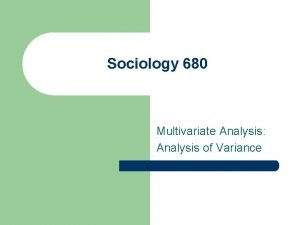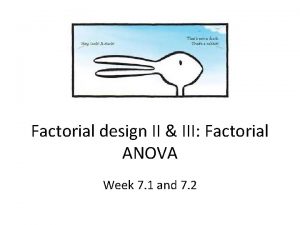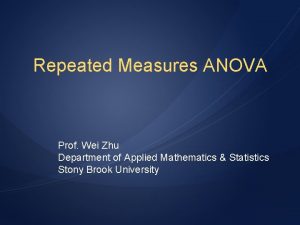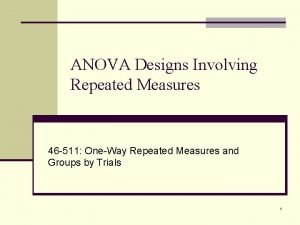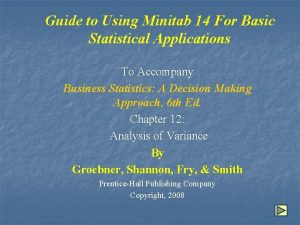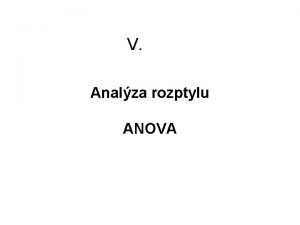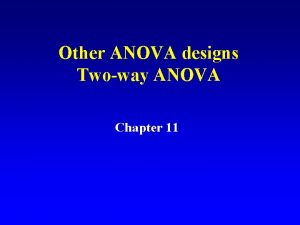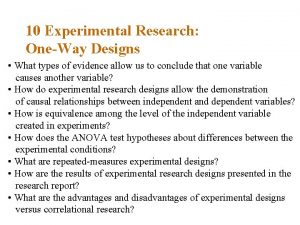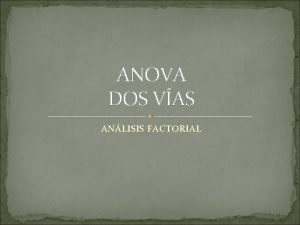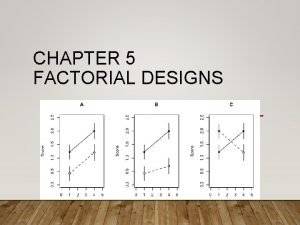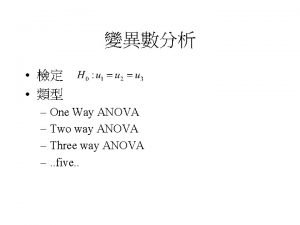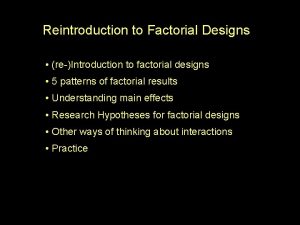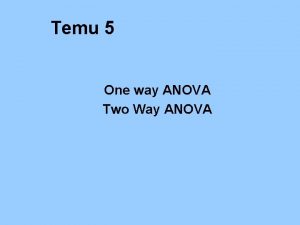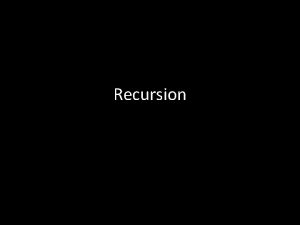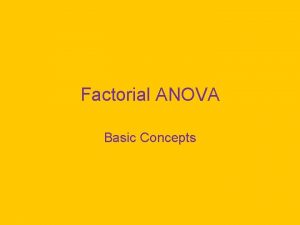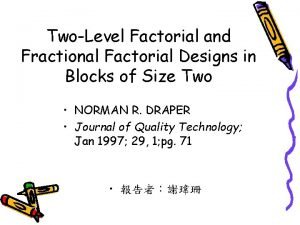Two Way ANOVA introducing factorial designs Interactions Interactions





















- Slides: 21

Two Way ANOVA introducing factorial designs

Interactions

Interactions

Factorial Designs l Factorial Designs are used when: – a study includes more than one categorical IV. – the researcher is interested in examining the relationship between several IVs and the DV. – the researcher is interested in the combined effects of the IVs.

Factorial Designs l Example 1: – A study of the relationships between teacher education level, several teaching strategies, and student achievement where teachers with varying degree levels were randomly assigned to the old curriculum or one of two new curricula.

Example 1

Factorial Designs l Example 2: – a study of the gains in student achievement made over time by male and female students, randomly assigned to receive different teaching methods (two innovative methods and one old method).

Example 2

ANOVA Design Terms l Between-Subjects IV – the levels represent independent groups – like independent t-test l Within-Subjects IV – the levels represent dependent conditions, typically time (pre, post, etc. ) – could also be multiple treatment conditions given to the same subjects – like dependent t-test

ANOVA Design Terms l Nested – some levels of the IV occur only within specific sites, or levels of another IV. – useful when treatments are nested within sites (schools, districts, states, etc. ). l Completely Crossed – all levels of each IV occur in combination with all levels of every other IV.

Two-Way ANOVA l Two-Way ANOVA is a statistical term that refers to a specific type of factorial design. l Two-Way ANOVA design includes two categorical IVs. l Both IVs are Between-Subjects terms. l They are completely crossed.

Interactions

Hypotheses l Two-Way ANOVA includes three sets of null and alternative hypotheses. l There is a null and alternative hypothesis for each of the two main effects. l There is also a null and alternative hypothesis for the interaction between the two IVs.

Interactions

Hypotheses l the hypotheses for the main effects are similar to those used for a One-Way ANOVA. l they address the effects of each IV taken separately. l they address the column and row effects in the design.

Interactions

Hypotheses l the null and alternative hypotheses for the interaction term are more complex. l see Huck for an explanation of how to write these hypotheses. l Huck describes a strategy for addressing consistent patterns within rows and columns, in both words and symbols.

Interactions l an interaction effect tests for the combined effects of several IVs. l it examines whether the patterns to the means within the rows or columns are similar. l it examines whether any cell mean is out of the pattern that would be expected given the pattern of the main effects.

Assumptions l The assumptions of the Two-Way ANOVA procedure are the same as those for the One-Way procedure. l Violations of the assumptions of normality and homogeneity of variance are more problematic when there are grossly unequal cell sizes.

Example Stress levels by Location and Intention to return

Example Main Effect 1: Location of school Main Effect 2: Teacher intention to return Interaction Between Location and Intention to return
 Perbedaan anova one way dan two way
Perbedaan anova one way dan two way One way anova vs two way anova
One way anova vs two way anova Pengertian two way anova
Pengertian two way anova Perbedaan one way dan two way anova
Perbedaan one way dan two way anova 2 way anova example
2 way anova example Within-subject design example
Within-subject design example Factorial anova
Factorial anova Factorial anova
Factorial anova Two way anova minitab 17
Two way anova minitab 17 Anova in research
Anova in research F testi hesaplama
F testi hesaplama Repeated measures anova
Repeated measures anova Two-way repeated measure anova
Two-way repeated measure anova Two way anova minitab 17
Two way anova minitab 17 Two way anova sas
Two way anova sas Anova two way
Anova two way Two-way anova table
Two-way anova table 미니탭 gage r&r 해석
미니탭 gage r&r 해석 3 way factorial design
3 way factorial design Frequency trig
Frequency trig Threaded binary tree definition in data structure
Threaded binary tree definition in data structure One way design
One way design






